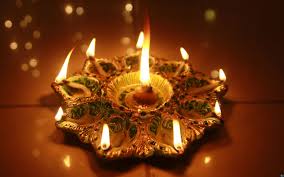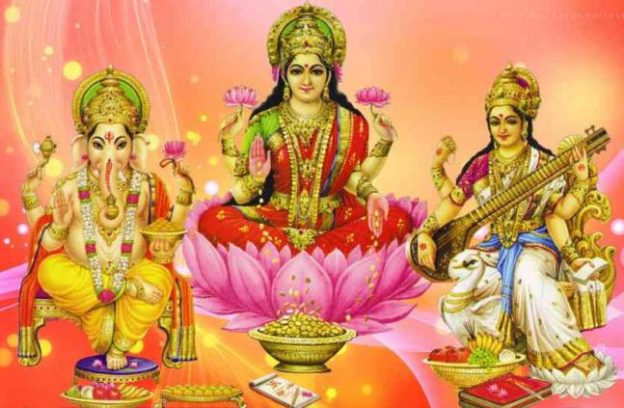Diwali is also known as Deepavali, Dipavali, Dewali, Deepawali, or the Festival of Lights. It is celebrated in October or November each year. Diwali celebrations can last for about five days.

What Do People Do?
Millions of Hindus around the world celebrate Diwali with gift exchanges, fireworks and festive meals. The Diwali celebration in India takes place when the monsoon season ends and the weather is mild and pleasant. People try to pay off their old debts, make or buy new clothes and thoroughly clean their houses as part of the festival preparations. House exteriors are whitewashed and sometimes decorated with designs drawn in white rice flour and filled in with color. Buildings are traditionally illuminated with oil-burning bowls called dipa lights, or more recently, with strings of artificial lights. People spend time with their friends and family.
On the first day of the festival people pray, eat a special breakfast consisting of different foods, and the Hindu goddess Lakshmi’s statue is carried throughout the streets in procession. Children are sometimes given candy or toys from booths set up for the occasion. In southern India children wear flower wreaths on their heads or anklets of bells. Boys in some areas construct elaborate castles and forts of mud and display them for visiting guests. After dark there are fireworks and people who live near rivers float lighted lamps on tiny rafts. To add to the festival of Diwali, melas (fairs) are held throughout India. These are found in many towns and villages.
Public Life
Diwali is a gazetted holiday in India so government offices and many businesses (including local offices and shops) are closed. It is not a nationwide public holiday in countries such as Australia, Canada, the United Kingdom and the United States but some cities hold large celebrations for the Diwali festival.

Background
Diwali is called the Festival of Lights and is celebrated to honor Rama-chandra, the seventh avatar (incarnation of the god Vishnu). It is believed that on this day Rama returned to his people after 14 years of exile during which he fought and won a battle against the demons and the demon king, Ravana. People lit their houses to celebrate his victory over evil (light over darkness). The goddess of happiness and good fortune, Lakshmi, also figures into the celebration. It is believed that she roams the Earth on this day and enters the house that is pure, clean, and bright.
The Diwali festival in southern India often commemorates the conquering of the Asura Naraka, a powerful king of Assam, who imprisoned thousands of inhabitants. It was Krishna, a deity worshipped in Hinduism, who was finally able to subdue Naraka and free the prisoners. Diwali celebrations may vary in different communities but its significance and spiritual meaning is generally “the awareness of the inner light”. It is also the beginning of the new financial year for the business community.
Symbols
Lamps, fireworks and bonfires illuminate this holiday, as the word “Deepawali” means “a row or cluster of lights” or “rows of diyas (clay lamps)”. The festival symbolizes the victory of righteousness and the lifting of spiritual darkness. During Diwali, or Deepawali, the goddess Lakshmi, who symbolizes wealth, happiness and prosperity, is also worshipped.
Note: It is not possible to mention every activity that takes place on this occasion as celebrations vary in different regions. However, this article provides a general overview of the main celebrations that usually occur during this event. Moreover, the date in which Diwali is celebrated may vary depending on locations and calendar interpretations.
Credits to :timeanddate.com
Where does the name Diwali come from?
The word Diwali comes from the Sanskrit word deepavali, meaning “rows of lighted lamps”.
Houses, shops and public places are decorated with small oil lamps called diyas. People also enjoy fireworks and sweets too, so it’s really popular with children.
What’s the festival about?
Each religion marks different historical events and stories.
Hindus celebrate the return of deities Rama and Sita to Ayodhya after their 14-year exile. They also celebrate the day Mother Goddess Durga destroyed a demon called Mahisha.
Sikhs particularly celebrate the release from prison of the sixth guru Hargobind Singh in 1619. But Sikhs celebrated the festival before this date.
In fact, the foundation stone of the Golden Temple at Amritsar, the most holy place in the Sikh world, was laid on Diwali in 1577. The founder of Jainism is Lord Mahavira. During Diwali, Jains celebrate the moment he reached a state called Moksha (nirvana, or eternal bliss).

Where does the name Diwali come from?
The word Diwali comes from the Sanskrit word deepavali, meaning “rows of lighted lamps”.
Houses, shops and public places are decorated with small oil lamps called diyas. People also enjoy fireworks and sweets too, so it’s really popular with children.
What’s the festival about?
Each religion marks different historical events and stories.
Hindus celebrate the return of deities Rama and Sita to Ayodhya after their 14-year exile. They also celebrate the day Mother Goddess Durga destroyed a demon called Mahisha.
Sikhs particularly celebrate the release from prison of the sixth guru Hargobind Singh in 1619. But Sikhs celebrated the festival before this date.
In fact, the foundation stone of the Golden Temple at Amritsar, the most holy place in the Sikh world, was laid on Diwali in 1577. The founder of Jainism is Lord Mahavira. During Diwali, Jains celebrate the moment he reached a state called Moksha (nirvana, or eternal bliss).
दीवाली को दीपावली, दीपावली, दीवाली, दीपावली या प्रकाशोत्सव के रूप में भी जाना जाता है। यह प्रत्येक वर्ष अक्टूबर या नवंबर में मनाया जाता है। दिवाली समारोह लगभग पांच दिनों तक चल सकता है।
लोग क्या करते है?
दुनिया भर में लाखों हिंदू उपहार, आतिशबाजी और उत्सव के भोजन के साथ दिवाली मनाते हैं। भारत में दिवाली का जश्न तब होता है जब मानसून का मौसम समाप्त होता है और मौसम हल्का और सुहावना होता है। लोग अपने पुराने ऋणों का भुगतान करने, नए कपड़े बनाने या खरीदने की कोशिश करते हैं और त्योहार की तैयारियों के तहत अपने घरों को अच्छी तरह से साफ करते हैं। हाउस एक्सटीरियर को व्हाइटवॉश किया जाता है और कभी-कभी सफेद चावल के आटे में खींची गई और रंग से डिजाइन की जाती है। इमारतें पारंपरिक रूप से तेल से जलने वाले कटोरे से रोशन होती हैं जिन्हें डिप लाइट्स कहा जाता है, या हाल ही में कृत्रिम रोशनी के तारों के साथ। लोग अपने दोस्तों और परिवार के साथ समय बिताते हैं।
त्योहार के पहले दिन लोग प्रार्थना करते हैं, विभिन्न खाद्य पदार्थों से युक्त एक विशेष नाश्ता खाते हैं, और हिंदू देवी लक्ष्मी की प्रतिमा को जुलूस में पूरे रास्ते भर ले जाया जाता है। बच्चों को कभी-कभी इस अवसर के लिए स्थापित बूथों से कैंडी या खिलौने दिए जाते हैं। दक्षिणी भारत में बच्चे अपने सिर या घंटियों के फूलों की माला पहनते हैं। कुछ क्षेत्रों में लड़के मिट्टी के विस्तृत महल और किलों का निर्माण करते हैं और मेहमानों के आने के लिए उन्हें प्रदर्शित करते हैं। अंधेरा होने के बाद आतिशबाजी होती है और नदियों के पास रहने वाले लोग छोटे-छोटे राफ्टों पर रोशनियां जलाते हैं। दीवाली के त्योहार में जोड़ने के लिए, पूरे भारत में मेलों (मेलों) का आयोजन किया जाता है। ये कई कस्बों और गांवों में पाए जाते हैं।सार्वजनिक जीवन
भारत में दिवाली एक राजपत्रित अवकाश है इसलिए सरकारी कार्यालय और कई व्यवसाय (स्थानीय कार्यालयों और दुकानों सहित) बंद हैं। यह ऑस्ट्रेलिया, कनाडा, यूनाइटेड किंगडम और संयुक्त राज्य अमेरिका जैसे देशों में एक राष्ट्रव्यापी सार्वजनिक अवकाश नहीं है, लेकिन कुछ शहरों में दीवाली त्योहार के लिए बड़े उत्सव आयोजित किए जाते हैं।पृष्ठभूमि
दिवाली को प्रकाशोत्सव कहा जाता है और सातवें अवतार (भगवान विष्णु के अवतार) राम-चन्द्र को सम्मानित करने के लिए मनाया जाता है। ऐसा माना जाता है कि इस दिन राम 14 साल के वनवास के बाद अपने लोगों के पास लौटे थे, जिसके दौरान उन्होंने राक्षसों और राक्षस राजा, रावण के खिलाफ लड़ाई लड़ी और जीती थी। लोगों ने बुराई पर प्रकाश (अंधेरे पर प्रकाश) पर अपनी जीत का जश्न मनाने के लिए अपने घरों को जलाया। सुख और सौभाग्य की देवी, लक्ष्मी भी उत्सव में शामिल होती हैं। यह माना जाता है कि वह इस दिन पृथ्वी पर घूमती है और उस घर में प्रवेश करती है जो शुद्ध, स्वच्छ और उज्ज्वल है।
दक्षिणी भारत में दीपावली का त्यौहार अक्सर असम के शक्तिशाली राजा, असुर नरका पर विजय प्राप्त करता है, जिन्होंने हजारों निवासियों को कैद किया था। यह कृष्ण, हिंदू धर्म में पूजित देवता थे, जो अंततः नरका को वश में करने और कैदियों को मुक्त करने में सक्षम थे। दिवाली समारोह अलग-अलग समुदायों में भिन्न हो सकते हैं लेकिन इसका महत्व और आध्यात्मिक अर्थ आम तौर पर “आंतरिक प्रकाश की जागरूकता” है। यह व्यवसाय समुदाय के लिए नए वित्तीय वर्ष की शुरुआत भी है।प्रतीक
दीपक, आतिशबाजी और अलाव इस अवकाश को रोशन करते हैं, क्योंकि “दीपावली” शब्द का अर्थ है “रोशनी की एक पंक्ति या क्लस्टर” या “दीयों (मिट्टी के दीपक)”। त्योहार धार्मिकता की जीत और आध्यात्मिक अंधकार को उठाने का प्रतीक है। दीपावली, या दीपावली के दौरान, धन, सुख और समृद्धि का प्रतीक देवी लक्ष्मी की पूजा की जाती है।नोट: इस अवसर पर होने वाली प्रत्येक गतिविधि का उल्लेख करना संभव नहीं है क्योंकि विभिन्न क्षेत्रों में उत्सव अलग-अलग होते हैं। हालाँकि, यह लेख मुख्य समारोह का एक सामान्य अवलोकन प्रदान करता है जो आमतौर पर इस घटना के दौरान होता है। इसके अलावा, जिस दिन दिवाली मनाई जाती है, वह स्थान और कैलेंडर व्याख्याओं के आधार पर भिन्न हो सकती है।
दिवाली नाम कहां से आया?
दीवाली शब्द संस्कृत शब्द दीपावली से आया है, जिसका अर्थ है “रोशन दीयों की पंक्तियाँ”।
घरों, दुकानों और सार्वजनिक स्थानों को छोटे तेल के दीयों से सजाया जाता है जिन्हें दीये कहते हैं। लोग आतिशबाजी और मिठाई का भी आनंद लेते हैं, इसलिए यह बच्चों के साथ वास्तव में लोकप्रिय है।त्योहार के बारे में क्या है?
प्रत्येक धर्म अलग-अलग ऐतिहासिक घटनाओं और कहानियों को चिह्नित करता है।हिंदू अपने 14 साल के वनवास के बाद अयोध्या में देवताओं राम और सीता की वापसी का जश्न मनाते हैं। वे उस दिन को भी मनाते हैं जिस दिन देवी दुर्गा ने महिष नामक राक्षस का संहार किया था।
सिख विशेष रूप से 1619 में छठे गुरु हरगोबिंद सिंह की जेल से रिहाई का जश्न मनाते हैं। लेकिन सिखों ने इस तिथि से पहले त्योहार मनाया।
वास्तव में, अमृतसर में स्वर्ण मंदिर की नींव, सिख दुनिया में सबसे पवित्र स्थान, 1577 में दीवाली पर रखी गई थी। जैन धर्म के संस्थापक भगवान महावीर हैं। दीवाली के दौरान जैन मोक्ष (निर्वाण, या अनन्त आनंद) नामक एक अवस्था में पहुँचते हैं।
दिवाली नाम कहां से आया?
दिवाली शब्द संस्कृत शब्द दीपावली से आया है, जिसका अर्थ है “रोशन दीयों की पंक्तियाँ”।
घरों, दुकानों और सार्वजनिक स्थानों को छोटे तेल के दीयों से सजाया जाता है जिन्हें दीये कहते हैं। लोग आतिशबाजी और मिठाई का भी आनंद लेते हैं, इसलिए यह बच्चों के साथ वास्तव में लोकप्रिय है।
त्योहार के बारे में क्या है?
प्रत्येक धर्म अलग-अलग ऐतिहासिक घटनाओं और कहानियों को चिह्नित करता है।
हिंदू अपने 14 साल के वनवास के बाद अयोध्या में देवताओं राम और सीता की वापसी का जश्न मनाते हैं। वे उस दिन को भी मनाते हैं जिस दिन देवी दुर्गा ने महिष नामक राक्षस का संहार किया था।
सिख विशेष रूप से 1619 में छठे गुरु हरगोबिंद सिंह की जेल से रिहाई का जश्न मनाते हैं। लेकिन सिखों ने इस तिथि से पहले त्योहार मनाया।
वास्तव में, अमृतसर में स्वर्ण मंदिर की नींव, सिख दुनिया में सबसे पवित्र स्थान, 1577 में दीवाली पर रखी गई थी। जैन धर्म के संस्थापक भगवान महावीर हैं। दीवाली के दौरान जैन मोक्ष (निर्वाण, या अनन्त आनंद) नामक एक अवस्था में पहुँचते हैं।
Please consider Donating to keep our culture alive


